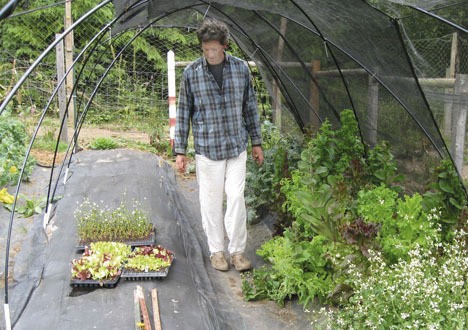In the middle of the heat-wave, I was dreaming of winter. Not to cool off, but to consider whether I can squeeze in a fall/winter garden.
My lettuce has bench-pressed its shade-cloth into the air. The overweight cabbages keeled over last week. The 49-square-feet of pea vines are supporting, what, maybe a tablespoon of peas?
Even tomatoes are ready: July 30th for my “Siletz,” by July Fourth for tomato specialist Michelle Crawford of Pacific Potager. James Dam of the Lutheran Church garden, declaring this “a great tomato year,” is salivating over the thought of, for once, ripening some brandywines.
With my spring veg jaundiced and hang-dog in the noon-day sun, even I must admit they’re way past admiring. Time to cook ’em or compost ’em, Karen. But maybe there’s time for another crop to keep those good eats coming?
Winter vegetables to seed now
So I called some gardeners—among them, Jenn Coe of Good Food Gardens, who was tapped by the Vashon Maury Community Food Bank to start a winter produce plot.
“Before July ends, you plant fall cauliflower, root crops, brassicas—brussell sprouts and parsnips as early as possible,” she said. “Things that grow fast like arugula, mustard, radishes, lettuce, you can plant all through August and September. For a winter supply of Swiss Chard, get it in by Sept. 21st.”
She recommended a “fantastic” chart in the fall/winter catalogue of Territorial Seed Company.
“You need to get the plants started when there’s still enough daylight, get them to a decent size by the fall equinox. Then they’ll sit in the ground over the winter and start growing again when the crocus bloom.”
But it’s so hot, I said. Won’t the seedlings just shrivel up and die?
“I grow my seedlings on a deck that has only four hours of sun,” she said. “The ambient air is at the right termperature for germination, and they can get really dry in full sun. I use an open flat without individual cell so the plants share the water.”
Margaret Hoeffel of the former Blue Moon Farm and now Shoulder-to-Shoulder Collective acknowledged it is getting late for some seeds, but added, “I typically don’t plant spinach until August. All the mustard greens you can plant in August and September and have a wonderful fall crop.”
She suggested, if we have another heat-wave when I want to start spinach, to put the seeds in the fridge for a couple of days: “I had radically better results after cooling the seeds before planting.”
The collective she’s now involved in, Shoulder-to-Shoulder, has had transplants for sale at the Saturday Farmers Market, some of which are still available directly from Shoulder-to-Shoulder: kales, some cabbage, some brussel sprouts, “and that purple broccoli that overwinters and you get little purple sprouts in March.” (Call Margaret at 463-1224 to make arrangements to buy starts.)
Hearing I can use seedlings again seems like a good idea to me. I can pull spring plants like cabbage or chard as I need them and drop baby plants into their place.
But the lettuce, I hate to yank. Towers, sure, straight to the compost. But the not-quite-mature lettuce I can de-bitter with an hour’s soak in cool, lightly-salted water — why not leave them for awhile?
The reason, I was told, is that I need that ground for carrots, beets and other root vegetables, which work best direct-seeded and need to be planted right NOW. “That way, by October, your carrots will be a beautiful little size,” said long-time gardener Opal Montague. “I put burlap bags over the planted seeds and keep them wet. I peek under the bags every day, because if the seeds germinate and don’t stay wet, they’re going to die.”
Both Jenn Coe and Master Gardener Nancy Lewis-Williams think it’ll still be possible to direct-seed into early August. After that, except for the greens listed above, you need transplants. So I checked: Kathy’s Corner and Dig will have veggie transplants through mid-August, and some VIGA growers will also offer seedlings. Langley Fine Gardens has raised transplants of fall lettuces, chard, broccoli, brussel sprouts, kale, plus onions and leeks: These are available now at Thriftway and Kathy’s Corner as well as their farmstand in Dockton at 10012 SW 268th Street.
So, pull one, then plant one, right? More like, pull two, plant one: Lewis-Williams has noticed that fall/winter vegetables “really do grow better if you give each one more space.”
Jenn Coe pointed out that with fall crops, “you can’t really cut and come again: Their growth is much slower. You need to make space for all the plants you’ll going to want, because you’re not going to be re-planting.”
“The second reason you need more space is that plants need air circulation when it’s so wet. You don’t want them touching each other, but to have room to dry out. Row covers help keep water off. Even in a greenhouse, space the lettuce a lot further to improve air circulation and discourage disease.
Kiss the spring goodies goodbye
So I’m convinced: The peas, the lettuce, ALL must go. In their place goes aged compost to refresh the soil, then some of those fall seeds from Ed Hume or Territorial Seed Company. And if I can’t seed before mid-August, I know where to find transplants.
And I’ll eat my spring beets (and chard, corn salad and cabbage) to make enough room for a fall/winter garden. Good thing I just figured this out …
Beet Berry Jello
Traditional winter fare in a summer dessert—a very cool way to deal with a heat-wave.
1/2-1 cup grated purple beets
equal quantity raspberries
Mix and sweeten with sugar and a splash of berry jam or raspberry “Torino” soda syrup. At the appropriate time, fold into:
Black Cherry Jello, substituting a berry-flavored liquid for one cup of the water. Serve plain or with whipped cream.
— Karen Dale gardens on a hillside on the south end of Vashon.



